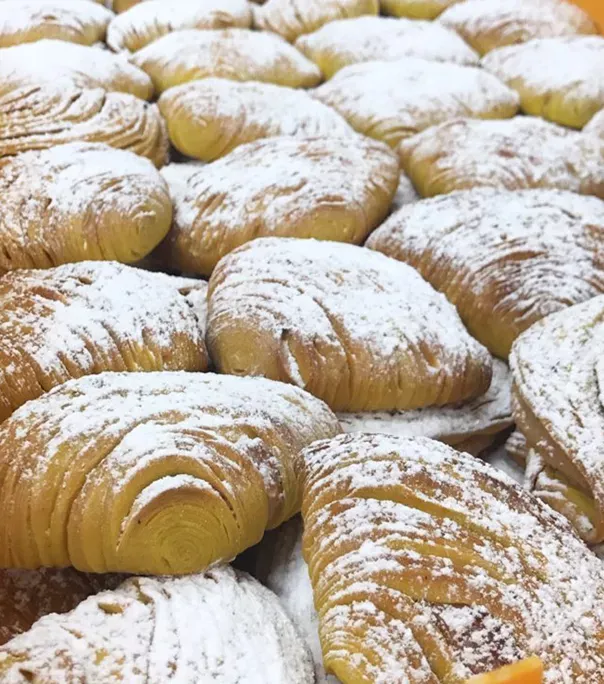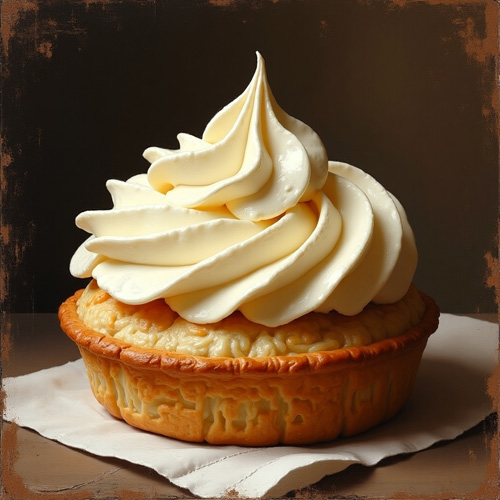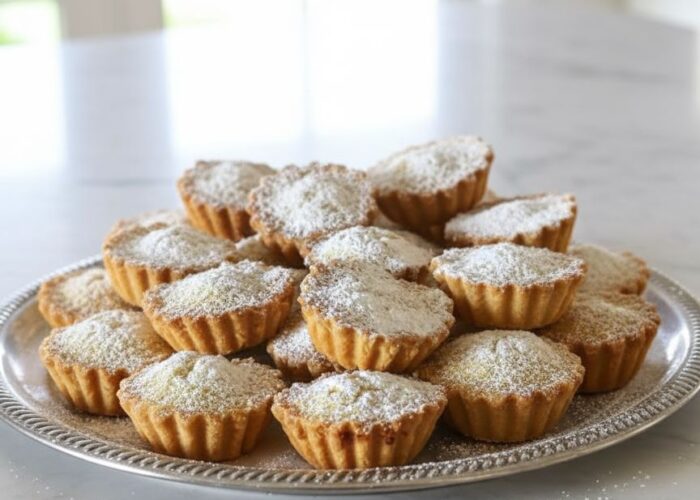Sfogliatella: Naples’ Iconic Shell-Shaped Pastry
Few pastries say “Naples” like the sfogliatella. Born in the 17th century in a convent near Salerno on the Amalfi Coast, this flaky, filled treat started as a clever way for nuns to use leftover semolina and ricotta. They mixed in sugar, dried fruit, and cinnamon, then wrapped it all in whisper-thin layers of dough.
The result? A crisp, shell-shaped pastry with a sweet, creamy center—and a name that means “little leaf” in Italian. Today, this is more than a dessert. It’s a symbol of Neapolitan pride—crunchy, rich, and rooted in centuries of pastry tradition.
The recipe traveled to Naples, where local bakers perfected it and gave us two beloved versions:
Sfogliatella Riccia vs. Sfogliatella Frolla
When it comes to sfogliatella, there are two main types—and while they share the same filling, their textures and dough make them totally different experiences.
Sfogliatella Riccia
This is the classic version most people picture. “Riccia” means curly, and it lives up to its name. Made with ultra-thin layers of stretched dough (similar to phyllo), sfogliatella riccia bakes into a crisp, golden shell that looks like a seashell or a stack of ruffled leaves. It’s flaky, crunchy, and makes a satisfying crackle with every bite. This is the one you’ll find in most Neapolitan pastry shops. If you Love crunchy pastries? Go with riccia.
Sfogliatella Frolla
“Sfogliatella frolla” swaps the flaky dough for a smooth, buttery shortcrust pastry. It’s rounder, softer, and has a more cookie-like texture. Easier to make at home and a bit more delicate, it still holds the same delicious ricotta-based filling inside. If you Prefer soft, tender textures? Go with frolla.
Both versions are iconic, and each shows a different side of Naples’ pastry tradition, bold and crisp on one hand, soft and delicate on the other. Both have the same delicious ricotta-based filling, but the textures are totally different.
Sfogliatella Riccia (Flaky Version)
Making Sfogliatella, especially the riccia version requires a bit of time, patience, and the right tools. Having the proper equipment on hand makes the process smoother and the results more authentic.
Pasta Machine or Dough Sheeter (optional but helpful). Rolling out the dough paper thin is crucial for achieving those signature flaky layers. A pasta machine saves a lot of time and effort.
Serving
Sfogliatelle aren’t just pastries—they’re an experience. Whether you’re enjoying them fresh from a bakery in Naples or homemade from your kitchen, how you serve them makes all the difference.
Serve Warm: Sfogliatelle are best served warm, straight from the oven or lightly reheated. When warm, the outer layers are ultra-crisp, and the filling becomes soft and aromatic, letting the flavors of ricotta, citrus, and cinnamon shine.
To reheat:
Pop them in a preheated oven at 350°F (175°C) for about 5–7 minutes. Avoid microwaving—it will make the pastry soggy and ruin the crunch.
Sfogliatelle are traditionally enjoyed with a strong espresso or cappuccino, especially in the morning. The rich, sweet filling pairs beautifully with the boldness of Italian coffee. Not a coffee drinker? A cup of black tea or herbal citrus tea also works well.
While sfogliatelle are usually served as-is, you can dust them with a light sprinkle of powdered sugar just before serving for an extra touch of elegance.
Storage
How to Store Sfogliatelle (Riccia & Frolla)
Sfogliatelle, whether riccia or frolla are best enjoyed fresh, but with the right storage, you can keep them tasting great for days (or even weeks, if frozen). Here’s how to store them properly without losing that signature flavor or texture.
Store in an airtight container at room temperature for up to 2 days. Keep them in a cool, dry place away from moisture to maintain crispness, especially important for sfogliatella riccia.
To bring back the crunch, reheat in the oven at 350°F (175°C) for 5–7 minutes before serving.
Refrigerating (Not Recommended): Avoid refrigerating baked sfogliatelle. The moisture in the fridge can make the pastry soggy and ruin the crisp texture of the riccia variety. Frolla is a little more forgiving, but room temperature is still best for short-term storage.
Freezing Unbaked Sfogliatelle (Best Method) for the best results. Arrange them on a baking tray, freeze until solid, then transfer to a freezer-safe bag or container. Freeze for up to 2 months.
To bake from frozen: No need to thaw. Bake straight from the freezer, just add an extra 5–7 minutes to the bake time.
Freezing Baked Sfogliatelle (If Needed)You can freeze fully baked sfogliatelle, though they may lose some crispness. Wrap each one tightly in plastic wrap, then place in an airtight container. Freeze for up to 1 month.
To reheat: Thaw at room temp, then re-crisp in a hot oven for 5–10 minutes.













